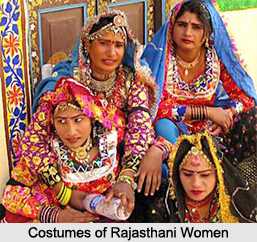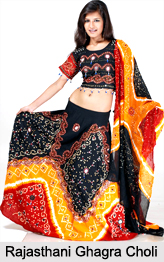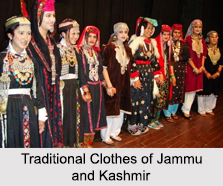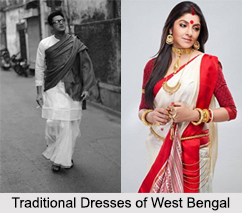 Costumes for Rajasthani women are much like the region and culture itself that are equally colourful. The status, moods, emotions and even the seasons are portrayed by the costumes of the Rajasthani women. Probably, all the colour and splendour of the state is reflected in the vitality of their dress and ornament.
Costumes for Rajasthani women are much like the region and culture itself that are equally colourful. The status, moods, emotions and even the seasons are portrayed by the costumes of the Rajasthani women. Probably, all the colour and splendour of the state is reflected in the vitality of their dress and ornament.
Ghaghra Choli of Rajasthani Women
For centuries, the costumes for Rajasthani women have featured a specific pattern of dressing that is particularly unique to that very state. The most commonly worn by the women in Rajasthan has been a combination of upper garment clothing that includes the "Puthia" or "Kanchli" and "Kurti"; and the lower garment clothing that includes the "Ghaghra" or skirt and the veil or "Odhni" that is draped to flow across the upper and lower parts of the body. There are numerous variations and additions to this ensemble across and within communities, depending on the wearer"s social position. However, these three items of dress comprise the essential costume that is typically worn by women in Rajasthan even today.
Factors for Costumes of Rajasthani Women
 The most important factor that determines variation in a woman"s costume in Rajasthan, within a community is her marital status. Bright colours, heavy ornamentation and rich fabrics that is associated with marriage, fertility and the status of a woman"s life. In sharp contrast, a widow"s dress, though similar in style, is dull in colour and lacks embellishment, emphasizing abstinence. Numerous variations in style, cut, colour and embellishment are clearly visible in the various communities of Rajasthan.
The most important factor that determines variation in a woman"s costume in Rajasthan, within a community is her marital status. Bright colours, heavy ornamentation and rich fabrics that is associated with marriage, fertility and the status of a woman"s life. In sharp contrast, a widow"s dress, though similar in style, is dull in colour and lacks embellishment, emphasizing abstinence. Numerous variations in style, cut, colour and embellishment are clearly visible in the various communities of Rajasthan.
The costumes of Rajasthani women are also an indicator of social status. For instance, the Rajput women, who belonged to the highest social order, customarily followed the Pardah system where women`s movements were, by-and-large, limited to the zenana. Their costume, in the privacy of the women`s quarters, could be elaborately decorated and free of restriction. Their Ghaghras were fairly short exposing beautiful leg ornaments, as are portrayed in numerous paintings. However, as the Pardah became outdated, Rajasthani women"s attire saw corresponding-changes to ensure the preservation of feminine modesty in public places. Therefore, the length of the Ghaghra was increased to avoid exposing any part of the leg and feet. The present day Rajput Ghaghra now trails on the ground that however looks even more beautiful. In contrast, many women who work in the fields wear Ghaghras, which end about 10 cm. above their ankles, as dictated by their occupation. They also wear leg and ankle bracelets that are not just for adornment, but also as protection against brambles and bites as they walk through the fields.
In some parts of Rajasthan, a single coloured Odhni tells that girl has not yet reached puberty, a large Bandhani circle on one corner of the odhni states that she is married; and a single large circle in the centre, in bright red, tells that she now is a mother. When the colour deepens, the circles become shadowy that means she is a widow. These concepts of form, colour and ornament are an integral part of the heartbeat of oral thought and tradition.
Costumes of Rajasthani women has been a dazzling piece of attire since ages and with the passage of time many more process have been implemented to make these costumes even more beautiful. However, the traditional style of Rajasthani attire still exists with few modern embellishments.





















